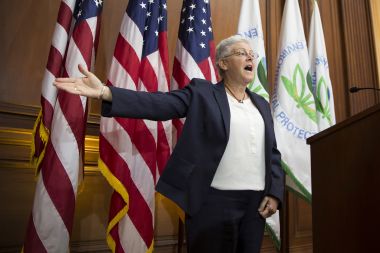Introduction

The Environmental Protection Agency on Monday proposed the first-ever limits on greenhouse gas emissions from existing power plants. The high-profile announcement marks the second time in less than a year the agency has released far-reaching rules aimed at fulfilling a key pillar of President Obama’s sweeping climate plan — to cut carbon pollution from both existing and planned power plants.
EPA Administrator Gina McCarthy unveiled a dense, 645-page proposal to limit carbon dioxide emissions from roughly 1,000 existing coal, gas, and oil plants nationwide — the largest source of carbon pollution in the United States, accounting for nearly one- third of all domestic greenhouse gas emissions. McCarthy presented the groundbreaking regulation as a “vital piece of President Obama’s climate plan” and “critical step forward” in the global fight against climate change.
“This is not just about disappearing polar bears or melting ice caps,” she said. “This is about protecting our health and our homes. This is about protecting local economies and jobs.”
Dubbed the “Clean Power Plan,” the EPA proposal would cut carbon emissions from existing plants by as much as 30 percent by 2030, as compared to 2005 levels — or, about 730 million metric tons of carbon pollution. Under this plan, state officials would develop energy-efficiency policies and renewable-energy programs to meet what the EPA has identified as state-specific goals for reducing carbon pollution.
To reach such “carbon targets,” the states could implement a range of options from designing a market-based carbon tax to using “no carbon” electricity sources like wind, solar, and nuclear. The EPA proposal would give states a flexible timeline for submitting their plans to the agency, with initial drafts or final plans due by June 2016.
Touting the plan’s “huge” benefits, including the billions of dollars saved in health-care costs because of fewer asthma attacks and premature deaths, the EPA administrator called it “an investment in better health and a better future for our kids.”
Alluding to the battle now brewing over carbon regulations for power plants, she added, “There are still special interest skeptics who will cry the sky is falling. Who will deliberately ignore the risks, overestimate the costs, and undervalue the benefits. But the facts are clear.”
Even before Monday’s announcement, the EPA’s plan to regulate carbon pollution from aging coal-fired power plants had set off a fierce lobbying campaign by coal companies and coal-burning utilities. Last fall, the agency announced its first-ever national standards to cut carbon dioxide emissions from planned power plants; those standards are pending. Like that rule, opponents consider Monday’s proposal to be an effective ban on coal plants.
“If these rules are allowed to go into effect, the administration for all intents and purposes is creating America’s next energy crisis,” said Mike Duncan of the American Coalition for Clean Coal Electricity, the coal industry’s most public voice. Noting how coal still accounts for nearly 40 percent of all electricity, he reiterated longstanding industry arguments about the costs of such stringent regulation — i.e., higher energy prices, lower grid reliability.
Other vocal opponents, like Jeffrey Holmstead, who represents coal and utility companies at the D.C. lobbying firm Bracewell & Guiliani, wondered whether EPA’s proposal would actually address such climate dangers as rising sea levels and soaring temperatures. “The way they’ve promoted the rule is highly misleading,” charged Holmstead, who headed the EPA’s air and radiation office under President George W. Bush. “This is the rule that’s going to address all these risks,” yet nowhere do EPA officials say how the proposed rule will do so.
Calling its overall goal “unrealistic,” he noted that many states have already implemented “easy fixes and easy improvements” to try to promote energy efficiency and renewable sources, thus reducing carbon pollution. Currently, according to the EPA, 38 states have their own renewable portfolio standards or goals; 27 have the same for energy efficiency. For most, Holmstead said, “I don’t think there’s any plausible way to comply without a cap and trade proposal or a carbon tax” — an option fraught with politics.
Not all power companies reacted negatively to the EPA’s proposal. Jack Ihle, of Xcel Energy, a large utility operating gas plants and wind farms in Minnesota and Colorado, acknowledged that the plan has the potential to significantly change the way the industry produces electricity. Seeing itself as an industry leader, Xcel has retired coal plants, renovated gas plants, and served as what Ihle called the “number one provider of wind energy to customers for 10 straight years,” all to try to reduce its carbon emissions.
Such moves “have been made very clear under this new rule,” Ihle said, adding that Xcel “hopes to achieve recognition of significant emission reductions” under it.
Environmental advocates welcomed the EPA proposal as a long time coming, applauding both its national limit and its political message. “We think this is the right direction,” said Abigail Dillen, of the public-interest law firm Earthjustice, which, like many environmental groups, will be pushing the EPA to cut carbon pollution even further in its final rule. She added, “The most important thing to do today is celebrate that the president has taken this tremendously courageous action.”
The EPA proposal must go through a 120-day public comment period and additional reviews. Next month, the agency also plans to hold four public hearings on the proposal, in Denver, Atlanta, Pittsburgh, and Washington, D.C. A final rule is expected by June 2015.
Read more in Environment
Environment
National Academy of Sciences agrees with EPA that formaldehyde causes cancer
Environment
Is this U.S. coal giant funding violent union intimidation in Colombia?
Alabama-based Drummond Co. sued for alleged ties to group behind deaths, threats


Join the conversation
Show Comments